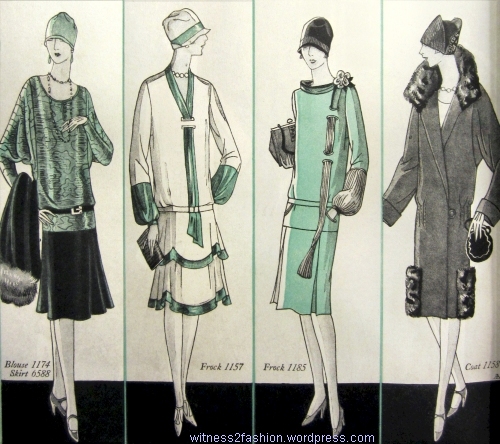The lavish use of fur in the twenties and thirties may be repellent to us now, but these fashions for December, 1926, are undeniably glamorous. They are all from Delineator magazine. Two images illustrate clothes in the stores — very exclusive stores — and the rest illustrate Butterick patterns (Delineator was a Butterick publication.) The suit pictured above is a Hattie Carnegie copy of a wine red velvet suit trimmed with beige fox, from the house of Paquin (French designer Jeanne Paquin had retired in 1920.)
Titled “Green and Gray,” the caption says “The New York version of the Paris ensemble is made by Frances Clyne in sea green bordered with dyed gray fox. The coat of green French wool swings slightly from the shoulder and is made with the new double animal collar. The frock is of green satin opening over lighter green crepe Elizabeth.” Frances Clyne operated an exclusive New York dress shop; in the 1930s, it was on Fifth Avenue.
This Butterick advertisement showed women how similar styles could be made at home, or by your own professional dressmaker.
“She has Paris taste and knowledge of clothes, and her Frock is Butterick Design 1155 and her Coat is Butterick Design 1105 made with the aid of the Deltor — a dressmaking chart in pictures for cutting, putting together, and finishing.” [punctuation added.]
Butterick was one of the first companies to offer a separate sheet of written instructions with its patterns. At the start of the twentieth century, patterns came with only the minimal instructions that would fit on the outside of the (usually quite small) pattern envelope. “By 1920, Butterick referred to the [illustrated] instruction sheet as the ‘Deltor,’ short for Delineator.” [Joy Spanbel Emery in A History of the Paper Pattern Industry.]
I love the bold Art Deco fabric on this sporty coat:

Butterick coat and dress patterns, Dec. 1926; A Chanel suit, January 1925. Both illustrations are from Delineator.
The dress shown with the coat (left) shows the lasting influence of Gabrielle Chanel’s outfit from January 1925. The proportions of the tops are slightly different to balance the skirt length, which has risen drastically in just two years.
Here are four more styles from Butterick, featured in the same December 1926 issue.
The deep armholes of the dress at left required a similarly constructed coat:
[Fine ‘Plaits’ means fine pleats, not braids.] The backs of many 1920s dresses and coats were straight and plain, but this coat is snugged to the hip with tucks in front and back.
So far, I have not seen any mention in Delineator magazine of how women obtained the furs which were so often an important design element in Butterick coats. (Working with real furs is not the same as sewing with fabrics, and where would a small-town dressmaker find whole skins?)
Also, notice how similar many of these 1926 cloche hats are, with pinched or dented crowns.








Hmm….you’ve got me wondering if fur pieces were offered in catalogs like Sears. I’m constantly amazed by what you could find in early catalogs, including wigs and hair pieces. I love those twenties coats, but have always wondered how they would hold up in a stiff wind.
I’ve seen accessory furs in Everyday Fashions, like those pitiful little foxes with beady glass eyes; I should go to the library and look for some complete Sears catalogs from the 1920s. Thanks for the idea!
There were wholesalers dealing in furs, furriers, tailors and professional dressmakers working with fur. I have read one account of remnants being collected from furriers – in Europe – and resold. In the major cities furs could be acquired fairly easily. Fur farming existed in the US I believe from the late 19th century and rabbit fur was very popular,cheap and could be dyed to resemble a more exotic fur. Home dressmakers in smaller North American rural towns could obtain locally sourced skins. Haberdashers may have sold fur trimmings and remnants. I’m thinking of hand mufflers. The 1920’s also saw fake fur produced from the alpaca. I have not come across catalogues from the period showing fur pieces sold for dressmaking.
Thanks for the reminder that rural areas would have access to locally cured and prepared furs. According to Jenna Weissman Joselit, in A Perfect Fit, there were only four fur farms in the U.S. before 1917, but there were thousands by 1930, so furs became relatively inexpensive. I still wonder how many coat patterns calling for large pieces of fur were actually made by home stitchers. Maybe they settled for cloth coats worn with fur stoles, which were easy to buy. And you’re right about rabbit — the names furriers came up with for rabbit skin pretending to be something else are worth study; I just saw an ad for sheared, dyed coney (rabbit) “generally sold as nearseal.”
Pingback: 1920s Orange and Black: Not Just for Halloween | witness2fashion